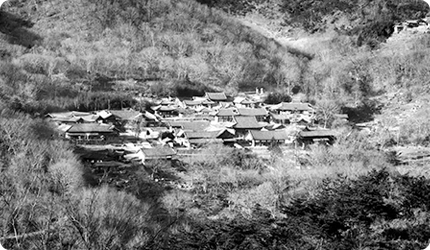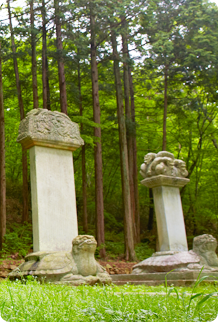Buddhist Mountain Monasteries in Korea
Seonamsa Temple
Seonamsa Temple
Introduction
Natural Environment
History
Temple Layout
Cultural Properties
Information
History of Seonamsa Temple
-
- There are two theories explaining the founding of Seonamsa Temple.
According to one theory, based on Suncheonbu-Jogyesan-Seonansa-jeyuk-changgeongi and Jogyesan-Seonamsa-sajeok-bi, Monk Ado Hwasang founded the temple in 529 (3rd year of reign of King Jinheung of Silla) and called it Haecheonsa of Cheongnyangsan Mountain, while the other suggests that it was founded as a protection temple by National Preceptor Doseon in 875 (1st year of King Heongang’s reign) and called Seonamsa.
Based on a comprehensive review of the historical records, it is most likely that Monk Ado Hwasang founded Haecheonsa, a small hermitage at Biroam, while its form as an actual temple at the present site was made possible by National Preceptor Doseon. -
 Seonamsa Temple during the Japanese occupational period
Seonamsa Temple during the Japanese occupational period
- While the initial size of the temple is not exactly known, large-scale reconstruction was initiated by National Preceptor Daegak Uicheon in the mid-Goryeo Dynasty, and considering its scale, the general outline and contour of the temple were created through this second reconstruction project of Seonamsa. At present, there are three sarira-stupas at Seonamsa Temple: Seonjoam-budo Stupa (est. construction: early 10th century) and Muujeon-budo and Daegagam-budo stupas (est. construction: late 10th century). Of these, Daegagam-budo Stupa is speculated to be that of Uicheon. Eunghyanggak Hall houses the upper monk robe bestowed upon Uicheon by his elder brother King Seonjong of Goryeo, and this reveals the relationship between the temple and the monk.
- There are two theories explaining the founding of Seonamsa Temple.
According to one theory, based on Suncheonbu-Jogyesan-Seonansa-jeyuk-changgeongi and Jogyesan-Seonamsa-sajeok-bi, Monk Ado Hwasang founded the temple in 529 (3rd year of reign of King Jinheung of Silla) and called it Haecheonsa of Cheongnyangsan Mountain, while the other suggests that it was founded as a protection temple by National Preceptor Doseon in 875 (1st year of King Heongang’s reign) and called Seonamsa.
-
-
 Seonamsa Jungsubi
Seonamsa Jungsubi
- Seonamsa Temple was completely destroyed during the Japanese Invasion of Korea in 1597 (Jeongyujaeran). Then, it regained its original appearance as it was rebuilt over the course of 8 years during the reign of King Hyeonjong, under the supervision of monks Gyeongjam, Gyeongjun and Munjeong.
The fourth reconstruction project was conducted by Great Monk Yakhyu. Wontongjeon Hall was erected in 1698, and the repair of Daebeopdang Hall (Great Buddhist Sanctuary) and reconstruction of Osipjeong took place in 1703. In 1707, Seungseongyo Bridge was rebuilt, and Seonamsa Jungsubi was erected.
A large number of buildings were burnt down by a disastrous fire that broke out in 1759. As a result, the fifth reconstruction was initiated in 1761 by monks Sangwol and Seoak. It was a large-scale reconstruction work that mobilized 551 workers, and its description is recorded in the Sangnyangmun (building erection) records discovered in Palsangjeon. It’s been said that Great Monk Sangwol renamed the mountain Cheongnyangsang and the temple Haecheonsa in hopes to prevent future fires. - The temple was rebuilt for the sixth time following a fire in 1823 (23rd year of King Sunjo’s reign) that destroyed Daeungjeon, Myeongbujeon, Jeongmunno Hyangnojeon, Seolseondang, and Simgeondang. The reconstruction work commenced in 1824 to restore these buildings. The records of the reconstruction work can be found in Suncheonbu-Jogyesan-Seonamsa-jeyuk-changgeongi, which states that the reconstruction took a short time as some 300 monks and priests of Seonamsa and several other temples contributed to the project. Those who played leading roles in the sixth reconstruction project were monks Haebung, Nuram and Ikjong. They first rebuilt Daeungjeon, Myeongbujeon, Jeongmunnu and Hyangnojeon before rebuilding Simgeomdang and Seolseondang in 1825. Also, this was when the former names Jogyesan and Seonamsan were restored. A photograph of Seonamsa Temple featured in Joseongojeokdobo created in 1933 shows that the temple had been relatively well-preserved following the sixth reconstruction in 1824. However, the temple once again suffered damages during the Yeosu Incident in 1948 as well as the Korean War, and the temple properties were sold during the land reform in 1952. Nevertheless, the main temple buildings have maintained their appearance from the sixth reconstruction, and Daeungjeon and other buildings have been repaired and rebuilt even in recent years.
-
Chronological table
| Time period | Description |
|---|---|
| 529 | Monk Ado Hwasang, comes to the area and names the mountain Cheongnyangsan and the temple Haecheonsa |
| 9th century | National Preceptor Doseon, founds Seonamsa as a bodhimandala |
| 11th century | National Preceptor Daegak, conducts a large-scale reconstruction work, building Chiljeonseonwon, etc. |
| 1540 | Iljumun Gate is rebuilt |
| 1597 | The entire temple is destroyed, except for 1 iron Buddha, 2 pagoda, 3 stupas, Munsujeon Hall, Jogyemun gate, Cheongcheuk(toilet) etc. during the Japanese Invasion of Korea in 1597 (Jeongyujaeran) |
| 1655 | Wongakgyeong (Mahavaipulya-purnabudha Sutra, or the Complete Enlightenment Sutra) is printed at Seonamsa |
| 1660 | Monks Gyeomjam, Gyeongjun and Unjeong begin reconstruction work, with some 10 colleagues which ensues for 8 years |
| 1707 | Monk Hoam builds Seungseongyo Bridge and erects Seonamsa Jungsubi |
| 1759 | Considerable damage is caused by fire |
| 1760 | Monks Sangwol and Seoak rebuilds Seonamsa Temple |
| 1761 | Great Monk Sangwol renames the mountain and temple as Cheongnyangsan and Haecheonsa in hopes to prevent fire |
| 1797 | Monk Haebong rebuilds Chiljeonseonwon |
| 1823 | Six living quarter buildings and 4 Buddha Halls including Daeungjeon are burnt down by fire |
| 1824 | Monks Haebung, Nuram and Ikjong rebuilds four temple buildings including Daeungjeon |
| 1825 | Monk Simgeom rebuilds Seolseonyangdan and reinstates the former names, Jogyesan and Seonamsa |
| 1906 | Seonamsa Meditation School is founded |
| 1911 | Seonamsa is chosen as one of the head temples of the Honam region when the 30 head temple system is initiated by the Japanese Government General of Korea |
| 1914 | Pogyodang is erected in the north of Gwangju, centering on Jeungsimsa, a branch temple of Seonamsa |
